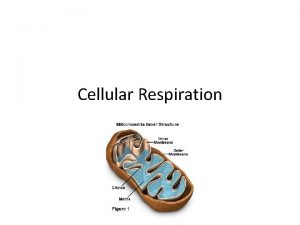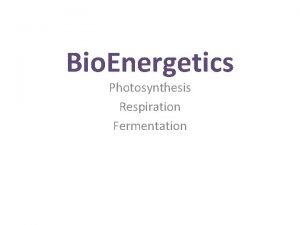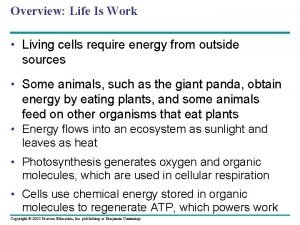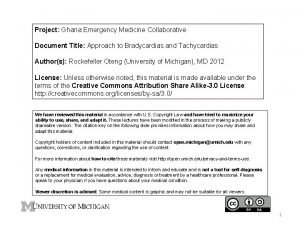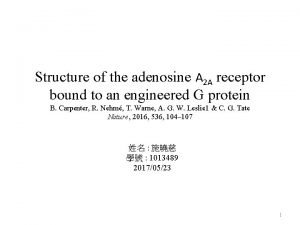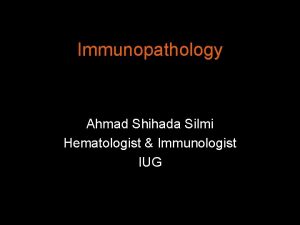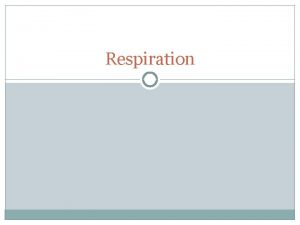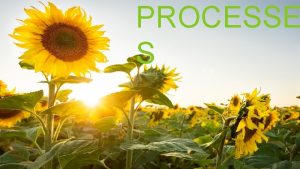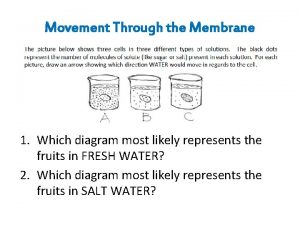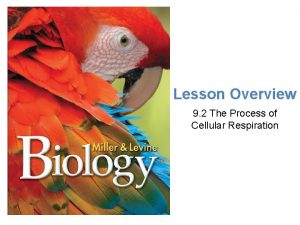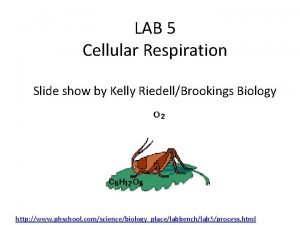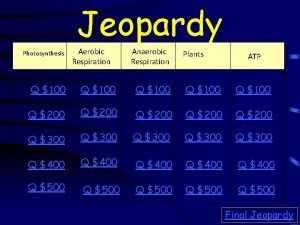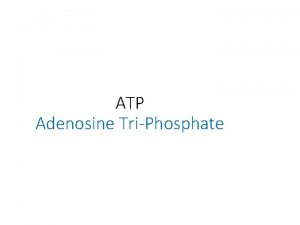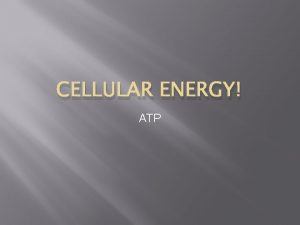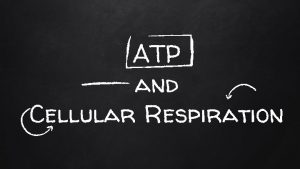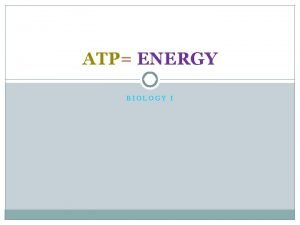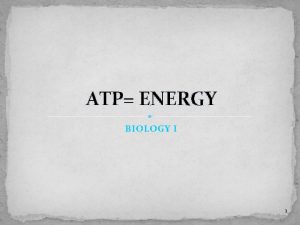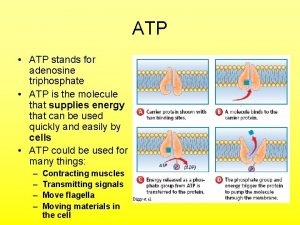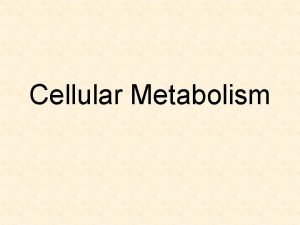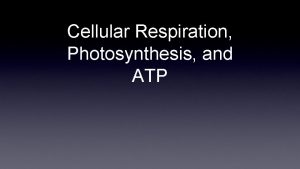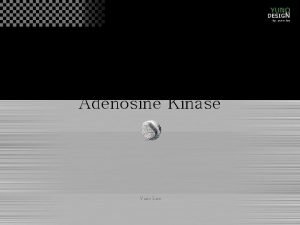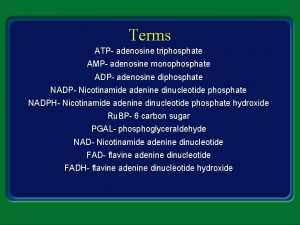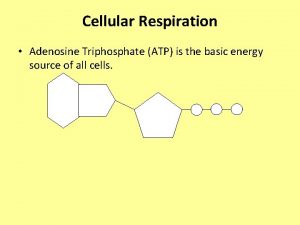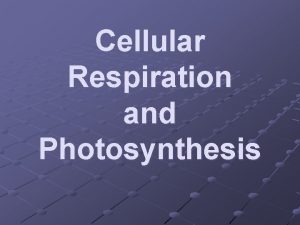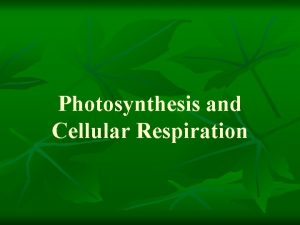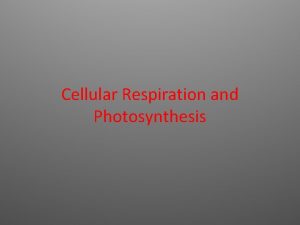Cellular Respiration Cellular respiration general information ATP adenosine
























- Slides: 24

Cellular Respiration

Cellular respiration: general information • ATP = adenosine triphosphate Diagram showing the molecular structure of ATP

Cellular respiration: general information • ATP = adenosine triphosphate • How does ATP give us energy? Diagram showing hydrolysis of ATP

So, energy produced in one reaction can ‘drive’ another reaction • How? – Redox reactions

Cellular respiration: general information • ATP = adenosine triphosphate • How does ATP give us energy? • ATP formation – Begins with glucose – Series of redox reactions – mitochondria Diagram of mitochondrion showing organization of cristae and matrix

Cellular respiration: general information • • ATP = adenosine triphosphate How does ATP give us energy? ATP formation Another important molecule – NADH Diagram of the reversible redox reaction between NAD+ and NADH

Cellular respiration • ATP formation, needs oxygen • 3 general stages Stage 1: glycolysis (processing glucose) • General diagram showing the three stages in cellular respiration • This slide highlights stage 1 as indicated. Occurs in cytoplasm of cells

Cellular respiration • ATP formation, needs oxygen • 3 general stages Stage 1: glycolysis Stage 2: Krebs Cycle (processing glucose) • General diagram showing the three stages in cellular respiration • This slide highlights stage 2 as indicated. Occurs in cytoplasm of cells Occurs inside Mitochondria, in mitochondrial matrix

Cellular respiration • ATP formation, needs oxygen • 3 general stages Stage 1: glycolysis Stage 2: Krebs Cycle (processing glucose) Stage 3: electron transport • General diagram showing the three stages in cellular respiration • This slide highlights stage 3 as indicated. Occurs in cytoplasm of cells Occurs inside Mitochondria, in mitochondrial matrix Cristae membrane

Stage 1: glycolysis GOAL = 29 ATP • What goes in? – Glucose (1) • What happens in this step? – Glucose broken down – ATP is used (initially) – 10 reactions, each with own enzyme • What is the result? – 2 pyruvate formed – 2 ATPs formed net – 2 NADH formed

STOP! • Remove game pieces from ‘glycolysis’ bag and place onto game board

Glycolysis (3) (2) Game pieces assembled to represent glycolysls (1) Glycolysis location on Mousetrap. TM gameboard

Stage 1: glycolysis GOAL = 29 ATP • What goes in? Glycolysis -2 ATP +4 ATP +2 NADH total +2 NADH +2 ATP – Glucose (1) • What happens in this step? – Glucose broken down – ATP is used (initially) – 10 reactions, each with own enzyme • What is the result? – 2 pyruvate formed – 2 ATPs formed net – 2 NADH formed • How is it regulated?

Stage 2: Krebs Cycle GOAL = 29 ATP • What goes in? – Pyruvate (formed during glycolysis, transported into mitochondria) • What happens in this step? – Pyruvate converted to Acetyl Co. A (initially) • 2 NADH produced – Acetyl Co. A starts Krebs Cycle – 8 reactions • What is the result? – – – Cycle turns twice 6 CO 2 6 NADH 2 FADH 2 2 ATP

STOP! • Remove game pieces from ‘Krebs Cycle’ bag and place onto game board

Krebs Cycle (1) (2) (3) Game pieces assembled to represent Krebs Cycle location on Mousetrap. TM gameboard

Stage 2: Krebs Cycle GOAL = 29 ATP • What goes in? – Pyruvate (formed during glycolysis, transported Glycolysis into mitochondria) • What happens in this step? – Pyruvate converted to Acetyl Co. A (initially) total -2 ATP +4 ATP +2 NADH +2 ATP • 2 NADH produced – Acetyl Co. A starts Krebs Cycle – 8 reactions • What is the result? – – – Cycle turns twice 6 CO 2 6 NADH 2 FADH 2 2 ATP • How is it regulated? Krebs Cycle +6 NADH +2 FADH 2 +2 ATP Total now = 4 ATP

Stage 3: electron transport chain GOAL = 29 ATP • What goes in? – NADH (produced in steps 1 and 2) – FADH 2 (produced in step 2) • What happens in this step? – Series of reactions beginning with NADH and FADH 2 – Oxygen is final electron acceptor – Energy released from reactions pumps protons across cristae membrane – Gradient of protons – Protons go back across membrane through a proton channel linked to ATP synthase – ATP is formed • What is the result? – 25 ATP (WOW!)

Stage 3: electron transport chain GOAL = 29 ATP • What goes in? – NADH (produced in steps 1 and 2) – FADH 2 (produced in step 2) Glycolysis • What happens in this step? – Series of reactions beginning with NADH and FADH 2 – Oxygen is final electron acceptor – Energy released from reactions pumps protons across cristae membrane – Gradient of protons – Protons go back across membrane through a proton channel linked to ATP synthase – ATP is formed • What is the result? – 25 ATP (WOW!) form Krebs Cycle form -2 ATP +4 ATP +2 NADH +2 ATP +6 NADH +2 FADH 2 +2 ATP Electron +25 ATP transport Total 29 ATP

STOP! • Remove game pieces from ‘electron transport chain’ bag and place onto game board

Electron Transport Chain (1) (6) (2) (5) (3) (4) Game pieces assembled to represent the electron transport chain Electron transport chain location on Mousetrap. TM gameboard

Now that the game is assembled. . . • Discuss the process of cellular respiration now that the three stages are connected on the game board – Have students identify the ‘start’ and ‘end’ for each of the 3 stages on the game board – Ask what happens if one component (such as oxygen) is removed – Ask what happens if one of the stages is removed

Make ATP (catch the mouse) • Ask the students to trigger the game by turning the crank labeled ‘glucose’ • Observe what happens • Discuss

For reference • Videos on youtube showing the overall flow/movement of the game – https: //www. youtube. com/watch? v=sy 840 Xvn QRA – https: //www. youtube. com/watch? v=H 6 Vmi. YJ_ IRk – https: //www. youtube. com/watch? v=1 GFNTpl. H b. Yc
 Adenosine triphosphate (atp)
Adenosine triphosphate (atp) Equation for photosynthesis
Equation for photosynthesis Difference between autotrophs and heterotrophs
Difference between autotrophs and heterotrophs Total atp produced in cellular respiration
Total atp produced in cellular respiration Overview of cellular respiration
Overview of cellular respiration Adenosine vs amiodarone
Adenosine vs amiodarone Deoxyribonucleotide adenosine
Deoxyribonucleotide adenosine Adenosine
Adenosine Fc silmi
Fc silmi Cellular respiration redox
Cellular respiration redox The gray-brown haze often found over large cities is called
The gray-brown haze often found over large cities is called Chemiosmosis steps
Chemiosmosis steps Types of respiration
Types of respiration Fermentation definition biology
Fermentation definition biology Why is cellular respiration important
Why is cellular respiration important Complementary processes
Complementary processes Summary equation for cellular respiration
Summary equation for cellular respiration Cellular respiration reactants
Cellular respiration reactants Photosynthesis recipe card
Photosynthesis recipe card Electron carriers in cellular respiration
Electron carriers in cellular respiration Overview of cellular respiration
Overview of cellular respiration Respiration overview
Respiration overview Cellular respiration
Cellular respiration Lab bench cellular respiration
Lab bench cellular respiration What is the word equation for cellular respiration
What is the word equation for cellular respiration
